November-December 1942
The end of a rough year for Paramount’s animated cartoon studio. A year of change for them – and the whole world. Here’s the view from these long unseen promotional panels in Paramount Sales News, the house organ for the Paramount “salesman, booker and exhibitor” (as noted in the 12/23 panel).
We’re at the peak of anti-Japanese sentiment in the Famous Studios product with these advertisements for Scrap the Japs and Eleventh Hour. We’ll still have plenty of war-related panels in the coming weeks, of course, with several appropriate appearances by Der Fuehrer.
I’m not going to make any wild guesses on artist IDs in this batch, but if some of our more inclined readers have an educated guess, we’d love to hear.
(click to enlarge)
Scrap The Japs (released November 20th 1942)
Eleventh Hour (released November 20th 1942)


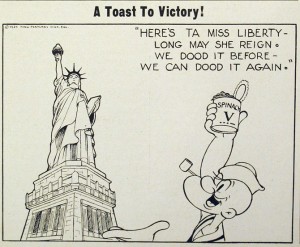
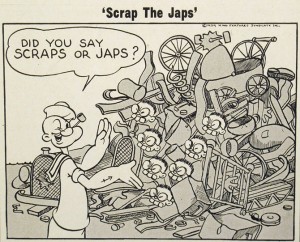

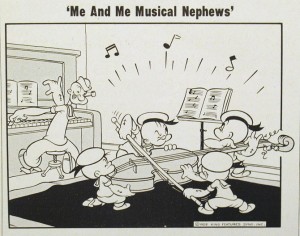



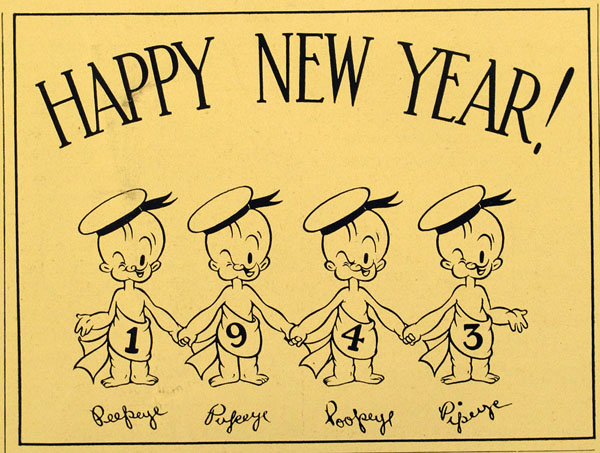
 THAD KOMOROWSKI is a writer, journalist, film restorationist and author of the acclaimed (and recently revised) Sick Little Monkeys: The Unauthorized Ren & Stimpy Story. He blogs at
THAD KOMOROWSKI is a writer, journalist, film restorationist and author of the acclaimed (and recently revised) Sick Little Monkeys: The Unauthorized Ren & Stimpy Story. He blogs at 
























































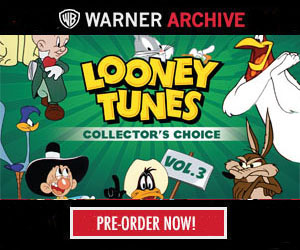
Superman in “Destruction, Inc.?” Never heard of that one.
https://www.youtube.com/watch?v=Ik-r0xxOxSE
Speaking of “Eleventh Hour,” does anyone know what that time symbolized and why Superman choose the stroke of 11 to do his destruction? My only guess was it was the hour the Pearl Harbor attack began.
“At the eleventh hour” is an old expression meaning “at the last moment”.
http://www.merriam-webster.com/dictionary/eleventh%20hour
A book I once read, about Hollywood during World War II, talked about how early in the war, there was a glut of films, like the Popeye’s of this era, that revolved around taking on, and defeating, the enemy. The book talked about how the government asked Hollywood to back off those kind of films, because they didn’t want them giving the American public the idea that the Nazis and the Japanese could be easily defeated and the war quickly won. They didn’t want the American people to underestimate what it would take to win the war.
I’ve heard the same thing about the decline of wartime shorts.
While Disney, Famous and others backed off on overt wartime-themed shorts, Warner Bros. was still releasing cartoons like Russian Rhapsody, Herr Meets Hare and Draftee Daffy into 1945. MGM never did many wartime shorts at all.
MGM’s “Peace On Earth” (1939), “Blitz Wolf” (1942), “Barney Bear’s Victory Garden” (`942), “War Dogs” (1943), “Bear Raid Warden” (1944), “Swing Shift Cinderella” (1945) are a few of their wartime cartoons that come to mind.
There’s that and there’s also the fact that as the war dragged on years later, audiences preferred escapism over constantly being reminded about the war.
A JOLLY GOOD FURLOUGH was pretty much the last Popeye cartoon that featured him directly in combat. By the time the series switched to color later in 1943, the cartoons rarely acknowledged the war except for military references or stateside war-related activity (MESS PRODUCTION). There was one last shot at the Japanese in the post-war ROCKET TO MARS. A pan shot of planets shows one that resembles an eight ball with a Japanese soldier emerging then quickly ducking behind it. In recent editing, the eight ball remains but the soldier is excised.
That cartoon always stuck out like a sore thumb to me simply because of the implication that the Japanese were still came out on these islands in the Pacific, not knowing the war had already ended, which did happen in real life with many Japanese soldiers having held out for a long time thinking the war was still happening. Still it’s interesting a Popeye cartoon, whether they were conscious of the matter or not, would suggest such a persistent situation.
http://en.wikipedia.org/wiki/Japanese_holdout
That’s one Superman they didn’t show on Rex Trailer’s Boomtown. Just as well – it’s really nothing but Superman smashing things up/
But I’m confused as to why American media are allowed to be in Yokohama. Was that standard?
The later Famous Studios Superman shorts aren’t my favorite personally due to stories like these (I use to see Jungle Drums as a kid and not really get what was happening because I didn’t have the context).
If you listen carefully during the first scene with Lois and Clark, Lois mentions they’ve been ‘interned’ in their hotel, so I think the implication is they were in Japan prior to Pearl Harbor and didn’t leave in time.
ROCKET TO MARS could have been a war-era cartoon that was held over. IIRC, Popeye alternates between Jack Mercer and Harry Welch in that cartoon.
Fred Grandinetti’s biography of Jack Mercer reproduces a letter to Mercer from Izzy Sparber after he was overseas, dated October 1943. So it was nearly 2 years before his absence shows up in the Popeye cartoons. (Though I think Mercer’s last onscreen story credit was 1944’s “Yankee Doodle Donkey”.)
“The Eleventh Hour” was also Willard Bowsky’s only directorial effort for Famous Studios and his last short before enlisting in the war and dying in the Battle of the Bulge.
Bowsky was the Fleischers’ most interesting director, when it came to putting a sense of power and/or menace into otherwise normal comedy shorts (if there’s a scene in a 30s Fleischer short designed to scare the kiddies in the audience, there’s about a 75 percent chance Bowsky was involved). So it’s an interesting ‘What if’ had he finished service during the war like other studio directors (Waldman, Johnson) and returned to Famous in the late 1940s, when it started running out of steam.
I’m most familiar with “Me Musical Nephews” from its inclusion in a Popeye collection released some years ago by some company with the mysterious name of “Thunderbean.” The cartoon seemed pretty energetic for post-Fleischer and had its moments. I particularly liked the nautical motifs in Popeye’s house, like anchors everywhere. (One surreal bit: at one point, Popeye is shown with *both* eyes open.) I did think *four* nephews is about one too many, and as a kid watching Popeye cartoons on Flippo the Clown’s afternoon kiddie show on Columbus, Oh. TV, I was flabbergasted that one of them was actually named “Poopeye.” That might have been the one to let go to cut it down to a more manageable three. I don’t suppose it was ever necessary to explain how Popeye had nephews in the first place. Did Poopdeck Pappy have another kid? Does Popeye have a sister or brother somewhere? Hey, I wondered about these things as a kid, when the more sensible adult attitude might have been, “It’s just a cartoon, they don’t have to explain anything.” Still, when Donald Duck’s nephews were introduced, Donald’s sister was at least mentioned as their parent….
Love the Oriental font in Hirohito’s letter to Superman. “Yeah, I coulda had Tokyo Rose broadcast it all over the Pacific, but a letter seemed much more personal.”